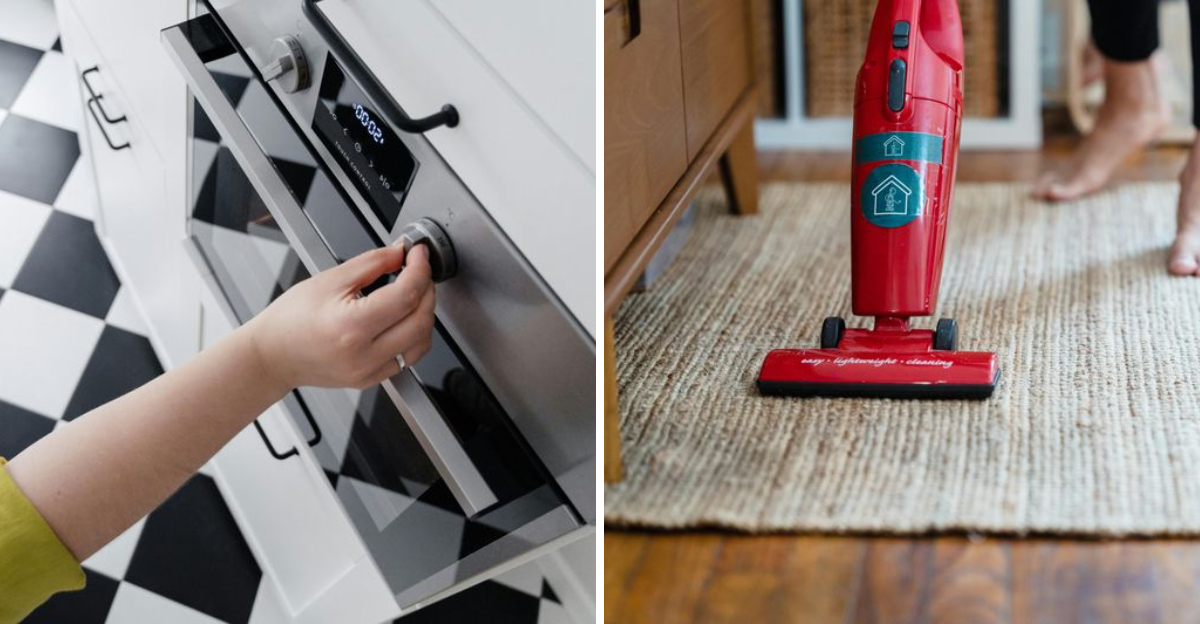8 Everyday Appliance Mistakes That Can Be Avoided

We rely on our appliances every day, but many of us are unknowingly shortening their lifespan or wasting energy through simple mistakes. From overloading washing machines to neglecting regular maintenance, these errors cost us money and frustration.
Understanding how to properly use and care for your household appliances not only extends their life but also improves their performance and safety.
Reminder: Every appliance is different, so check the manufacturer’s instructions for proper care.
1. Overloading Your Washing Machine
Cramming too many clothes into your washing machine might seem efficient, but it’s actually counterproductive. Your clothes won’t get properly cleaned, and the extra strain can damage the drum and motor over time.
The agitator needs room to move clothes around for thorough cleaning. When overloaded, fabrics can’t circulate properly, leaving dirt trapped in the fibers. Plus, an unbalanced load causes excessive vibration!
Fill your machine only three-quarters full, allowing room for clothes to move freely. Your machine will last longer, and your clothes will come out noticeably cleaner.
2. Neglecting Refrigerator Coils
Hidden coils on the back or bottom of your refrigerator play a crucial role in keeping your food cold. When dust and pet hair accumulate on these coils, your fridge has to work harder, using more electricity and potentially shortening its lifespan.
Most people never think about cleaning these coils, yet doing so twice yearly can improve efficiency by up to 30%. The process is very simple!
Unplug your refrigerator, locate the coils, and gently vacuum them using a brush attachment. Five-minute maintenance task can prevent costly repairs and reduce your energy bills significantly.
3. Running Dishwashers Half-Empty
Modern dishwashers use the same amount of water and energy regardless of how full they are. Running yours with just a few dishes wastes resources and increases wear on components that have a limited number of cycles.
Wait until you have a full load before starting a cycle. If odors concern you, rinse dishes lightly before loading them. For smaller households, consider using the half-load setting if your machine offers it.
Pre-rinsing dishes is usually unnecessary with today’s efficient machines. Scrape off food scraps, but let your dishwasher handle the actual cleaning-that’s what it’s designed to do!
4. Slamming Microwave Doors
That satisfying slam when closing your microwave door might feel good, but it’s secretly damaging the appliance. Microwave doors contain sensitive latch mechanisms and safety interlocks that can break when repeatedly slammed.
These safety features prevent the microwave from operating when the door is open. When damaged, they either stop working entirely or create false readings.
Close your microwave door with a gentle push instead of a forceful slam. This simple habit change costs nothing yet can extend your microwave’s life by years, saving you from unexpected replacements.
5. Ignoring Dryer Lint Traps
Forgetting to clean your dryer’s lint trap before each load creates a dangerous situation. Beyond being a fire hazard, lint buildup forces your dryer to work harder, using more energy and taking longer to dry clothes.
Many people clean the easy-to-reach lint screen but neglect the vent duct that leads outside. Hidden passageway should be cleaned annually to prevent restricted airflow and potential fire hazards.
Make it a habit to clean the lint screen before every load, not after. This ensures the next person won’t accidentally run the dryer with a clogged filter, and you’ll never forget this crucial maintenance step.
6. Using The Wrong Vacuum Setting
Those height adjustment settings on your vacuum aren’t just for show. They significantly impact cleaning effectiveness and can damage your floors when used incorrectly. Setting the vacuum too low can scratch hardwood.
On the flip side, a setting that’s too high won’t pick up dirt effectively. The right height allows the beater bar to gently contact the surface while still turning freely.
Adjust your vacuum for each floor type: higher settings for plush carpets, medium for standard carpets, and lowest settings for bare floors or very low-pile rugs. Your floors and vacuum will both last longer.
7. Leaving Appliances Plugged In Constantly
Many appliances continue drawing power even when turned off-a phenomenon called phantom or vampire power. This standby power consumption accounts for approximately 10% of residential electricity use.
Small kitchen appliances like toasters, coffee makers, and blenders don’t need to remain plugged in 24/7. Neither do chargers, gaming consoles, or desktop computers when not in use.
Consider using power strips to make it easier to cut power to multiple devices at once. Smart power strips can automatically cut power to peripheral devices when the main device is turned off, saving energy without any extra effort.
8. Skipping Oven Calibration
Most home cooks never realize their oven temperature could be off by 25-50 degrees! This discrepancy explains many baking disasters and inconsistent cooking results that leave you puzzled.
Oven thermostats naturally drift over time due to repeated heating and cooling cycles. An inexpensive oven thermometer can reveal if your oven runs hot or cold, allowing you to adjust accordingly.
Check your oven’s accuracy every six months by placing an oven thermometer in the center rack, preheating to 350°F, and comparing the readings. Many modern ovens have calibration settings you can adjust yourself.






